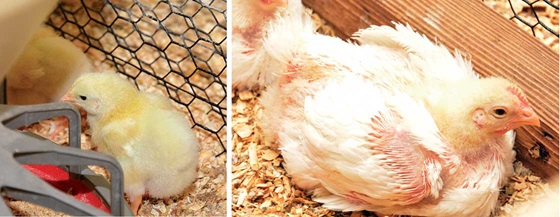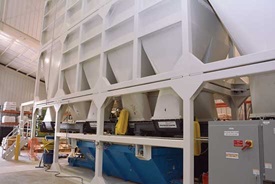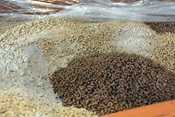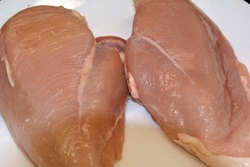Auburn Poultry Researchers Analyze the Cost of Freedom
INSIDE ACADEMIA
 The life of a commercially raised chicken is surprisingly simple and brief: Broilers (chickens used for meat production) are processed before they reach 13 weeks of age, and hens are productive egg layers for one to three years. The brevity of their lifespan belies the impact they have on the food supply. In Alabama, commercial poultry makes up more than 65% of annual farming revenues, and around the world, poultry will constitute the bulk of a sizable projected increase in meat consumption by 2025. Thus, poultry and egg producers have but a short time frame to produce billions of broilers and eggs that are nutritious, safe, and of good quality. “Poultry is a very modern food industry and very fast-paced,” says Donald Conner, professor and head of the poultry science department at Auburn University. “What happens during production has a great deal to do with the quality and safety of the final product. It entails the basics of food science, production, agriculture, [and] marketing.” To that end, scientists at Auburn University are deeply involved in research that enables the optimal nutrition, health, and safety of poultry (focusing primarily on broilers) and improves the efficiency of poultry production during a time of fundamental change. “We try to represent every phase of what it takes to produce poultry meat,” Conner says.
The life of a commercially raised chicken is surprisingly simple and brief: Broilers (chickens used for meat production) are processed before they reach 13 weeks of age, and hens are productive egg layers for one to three years. The brevity of their lifespan belies the impact they have on the food supply. In Alabama, commercial poultry makes up more than 65% of annual farming revenues, and around the world, poultry will constitute the bulk of a sizable projected increase in meat consumption by 2025. Thus, poultry and egg producers have but a short time frame to produce billions of broilers and eggs that are nutritious, safe, and of good quality. “Poultry is a very modern food industry and very fast-paced,” says Donald Conner, professor and head of the poultry science department at Auburn University. “What happens during production has a great deal to do with the quality and safety of the final product. It entails the basics of food science, production, agriculture, [and] marketing.” To that end, scientists at Auburn University are deeply involved in research that enables the optimal nutrition, health, and safety of poultry (focusing primarily on broilers) and improves the efficiency of poultry production during a time of fundamental change. “We try to represent every phase of what it takes to produce poultry meat,” Conner says.

The Biography of a Broiler
The lifespan of broiler chickens begins with the producing, laying, and hatching of fertilized eggs. There are a number of steps and stages that have to occur precisely for fertilized eggs to result in healthy broiler chickens: Primary breeder chickens produce a number of highly efficient parent lines from fertilized eggs. From these eggs, parent breeder chicks are hatched and then shipped to broiler farms. On broiler farms, parent breeders grow, mate, and produce fertile eggs from which broiler chickens are hatched. Other than supplying regular feed and water, farming practices have little effect on the nutritional makeup of broilers and the eggs from which they hatch: Nature ensures that each egg has everything it needs to produce life. “When you look at nutritional effects on product quality, for instance, there aren’t a lot of direct effects,” says Joseph Hess, an extension nutrition specialist and professor at Auburn. “The main thing that we look at regularly is the density of nutrition and how fast meat accrues. So much of our time is spent looking at the influence of nutrition on the amount of meat we have from chickens and the amount of eggs that are produced and that sort of thing.” Commercial broiler chickens are thus the result of artificial selection and breeding, which has resulted in birds that can reach a weight of five pounds in about five weeks. The diet of commercial broilers consists of feeds made predominantly of corn and soybeans and other ingredients in lesser amounts, but chickens will also eat grass seeds and insects. “Broilers are fed a feed that is really not substantially much different from what is fed to [laying] hens,” Hess explains. “The distribution of ingredients is slightly different, but the ingredients are pretty much the same.”
 Traditionally, commercial broilers live in pens within poultry houses with constant access to feed and water. The poultry houses are environments that farmers can control to ensure that conditions are optimal for each chicken’s health and development. It is a highly efficient system that allows the birds to achieve incredible gains in size while maintaining good health and product yield. “[This was done] to better protect the birds, to increase production rates and efficiency, and to get uniformity of quality. That shift took place in the ‘40s and ‘50s,” Conner says. Consumer perceptions, however, are causing the poultry industry to rethink and retool successful, efficient systems that have been in place for decades. Instead of raising chickens in poultry houses and pens and utilizing traditional preventive measures, some commercial poultry producers are committing to production systems that usher in a consumer-driven “free” era: free-range, cage-free, and antibiotic-free. “We as a food industry need to produce products that meet that demand, and that’s why we are beginning to see that shift,” Conner says. However, this level of freedom comes with a price.
Traditionally, commercial broilers live in pens within poultry houses with constant access to feed and water. The poultry houses are environments that farmers can control to ensure that conditions are optimal for each chicken’s health and development. It is a highly efficient system that allows the birds to achieve incredible gains in size while maintaining good health and product yield. “[This was done] to better protect the birds, to increase production rates and efficiency, and to get uniformity of quality. That shift took place in the ‘40s and ‘50s,” Conner says. Consumer perceptions, however, are causing the poultry industry to rethink and retool successful, efficient systems that have been in place for decades. Instead of raising chickens in poultry houses and pens and utilizing traditional preventive measures, some commercial poultry producers are committing to production systems that usher in a consumer-driven “free” era: free-range, cage-free, and antibiotic-free. “We as a food industry need to produce products that meet that demand, and that’s why we are beginning to see that shift,” Conner says. However, this level of freedom comes with a price.
Birds Without Borders
In a free-range system, chickens have access to the outside for some part of the day regardless of whether they actually choose to go outside. At night they return to the poultry house. “In free-range systems, you’ve got a lot of other issues that are just more difficult to manage as compared to birds that are kept in a barn,” Conner points out. Diet and nutrition are not among these issues. “There’s not a lot of substantial [nutritional] differences in birds raised different ways. There’ll be a little difference in coloration. Birds that are eating grass and things like that will have a little darker color, if they’re egg producers, to the yolk and that sort of thing,” Hess says. “Meat-wise, … the birds that are used for free-range take a little longer to reach production weight, at which a consumer would buy them, so they’re a little older. Their meat quality will be a little different, but that’s primarily genetics and age.” While free-range birds may be nutritionally equivalent to those raised in poultry houses, they are subject to three significant concerns: health, food safety, and predation. “There is some concern that when you have free-range chickens—since they’re outside more—they’re more exposed to the environment and they could more easily pick up different bacteria and viruses that they might not pick up if there were in a poultry house,” says Emefa Monu, an assistant professor in Auburn’s poultry science department. Conner amplifies this concern: “You don’t have to worry about hawks taking the birds out of the barn, but you do have to worry about that if birds are pastured—and weasels. From a food safety standpoint, there is a lot more exposure in free-range systems.”
 Cage-free systems raise similar concerns. The term “cage-free” is not applicable to broiler chickens because broilers are never caged. Cage-free birds are laying hens that live their entire lives roaming free in poultry houses. Obviously, because the laying hens remain in the poultry house, predation is not a concern, but food safety and health issues can emerge. “Cage production versus cage-free production is an interesting area to look at because the industry worked for a very long time to put hens in better and better housing where they could control the environment so that the birds were healthy and produced better,” Hess remarks. Cage production was a long-term attempt to produce an environment that would control what the birds are exposed to both from a health standpoint and from a temperature standpoint. “Consumers would like chickens to be on the floor so that they can move around, and that has really changed how we house chickens. Some of the things over the years that we have done to have birds be healthier are reversed when you have chickens on the floor,” Hess says. There is also a loss in yield because some of the eggs on the floor can be lost or, more notably, the birds can attack each other. “The term ‘pecking order’ is a real thing. When you move birds into more of a flock setting, you’ll get dominant and submissive birds. You have to be very cognizant of that and how you manage that. The whole goal is to alleviate that because that will create all kinds of problems within a flock,” Conner observes. Poultry workers thus have to work much harder to manage cage-free birds to keep them from pecking each other to death or cannibalization. “If you look at birds in a traditional cage setting, you have a very controlled environment. As you move to cage-free, you have a little less control of that environment. As you move to free-range, you have even less control in that environment. And in pasture systems, you have the least control. You have the weather, other animals, and so forth that hens could interact with,” Conner adds.
Cage-free systems raise similar concerns. The term “cage-free” is not applicable to broiler chickens because broilers are never caged. Cage-free birds are laying hens that live their entire lives roaming free in poultry houses. Obviously, because the laying hens remain in the poultry house, predation is not a concern, but food safety and health issues can emerge. “Cage production versus cage-free production is an interesting area to look at because the industry worked for a very long time to put hens in better and better housing where they could control the environment so that the birds were healthy and produced better,” Hess remarks. Cage production was a long-term attempt to produce an environment that would control what the birds are exposed to both from a health standpoint and from a temperature standpoint. “Consumers would like chickens to be on the floor so that they can move around, and that has really changed how we house chickens. Some of the things over the years that we have done to have birds be healthier are reversed when you have chickens on the floor,” Hess says. There is also a loss in yield because some of the eggs on the floor can be lost or, more notably, the birds can attack each other. “The term ‘pecking order’ is a real thing. When you move birds into more of a flock setting, you’ll get dominant and submissive birds. You have to be very cognizant of that and how you manage that. The whole goal is to alleviate that because that will create all kinds of problems within a flock,” Conner observes. Poultry workers thus have to work much harder to manage cage-free birds to keep them from pecking each other to death or cannibalization. “If you look at birds in a traditional cage setting, you have a very controlled environment. As you move to cage-free, you have a little less control of that environment. As you move to free-range, you have even less control in that environment. And in pasture systems, you have the least control. You have the weather, other animals, and so forth that hens could interact with,” Conner adds.
Despite the additional concerns involved in cage-free, and free-range, production, Conner believes that over time, more and more producers will convert to these systems. “Right now, the demand for cage-free eggs is small, but it is increasing. … We as a food industry need to produce products that meet that demand. The perception [is] that cage-free is a better way to produce eggs, and we have to respond to that as an industry. That shift is taking place in our production methods,” Conner says. “The difficulty is that it takes money to switch to those systems. So it’s a hardship on the industry to make that transition, but they’re committed to making that transition.”
Antibiotic-Free But Not Problem-Free
Auburn researchers are also working on solutions to what may be the most difficult of the free systems to implement: antibiotic-free poultry. Like humans and other animals, chickens can and do get sick. In addition, chickens can make humans sick. There are two sets of pathogens that can be present on poultry: pathogens that make poultry ill and pathogens that make consumers ill. “The pathogens that can be present on poultry products and are of concern mainly for consumers are Salmonella and Campylobacter. … Pathogens on chickens that are more of an issue for poultry health are E. coli and some Staphylococcus—that’s not to say that those can’t get people sick. But the [strains] that are getting chickens sick are not the ones that get people sick,” explains Ken Macklin, a professor and extension specialist in Auburn’s poultry department. Both of the pathogens present on poultry that are a health risk to humans (i.e., Salmonella and Campylobacter) are part of the normal microbiota of chickens. “With that said, there are a couple of Salmonella [strains] that do get chickens very sick,” Macklin continues. “When chickens get sick with these, they’re taken out of the food chain completely. Those two are Salmonella Gallinarum and Salmonella Pullorum.” Under the National Poultry Improvement Plan, which was established in the 1930s, poultry are immediately killed if they are found to have certain bacterial and viral diseases, such as Salmonella Gallinarum, Salmonella Pullorum, and avian influenza. For other pathogens that compromise poultry health, antibiotics are one way to control them. And until recently, antibiotics were administered to poultry for growth promotion as well as to prevent, control, and treat disease.
Motivated by the increasing incidence of antimicrobial resistance, the U.S. Food and Drug Administration (FDA) announced in December 2013 a voluntary plan to cease the use of certain antibiotics for growth promotion in food animals. And in December 2015, the FDA issued the Veterinary Feed Directive (VFD) final rule. The VFD final rule outlines the process for authorizing the use of VFD drugs and provides a framework for the use of medically important antimicrobials in feed when necessary for animal health. As of the end of 2016, it is illegal in the United States to use medically important antimicrobials in animals for growth promotion and feed efficiency (both of which facilitate uniformity of animal size). “Antibiotic use in poultry has changed—especially over the past couple of years,” Macklin observes. “The veterinary feed directive, which went into effect January of this year, helped play a role. But consumer preferences are really behind that push for antibiotic-free [poultry].”
Antibiotic-free poultry production is quite challenging, and there are a number of risks associated with it that make life more difficult for farmers as well as chickens. Most chickens are inoculated in ovo (i.e., before they are hatched) with vaccines containing certain antimicrobials to prevent specific fatal diseases. In ovo vaccination is newer (about 20 years in use) and absolutely necessary to prevent certain diseases, such as Marek’s disease, infectious bursal disease, and infectious bronchitis. Before in ovo vaccination, chickens were vaccinated by spraying them with vaccines and relying on the chickens to preen themselves. But vaccination spraying provides only about 80% coverage, so some chickens would not get enough of the vaccines to prevent disease. Once the chicks are hatched, if the birds never receive antibiotics again after two days of life, they can be deemed antibiotic-free. For farmers who have committed to providing antibiotic-free poultry, in ovo vaccination could protect the flock, but it also presents a hazard: “What we have seen is that more chicks are dying in that first week because that perfect little egg incubator was compromised with a hole [for in ovo vaccination],” Macklin says. “When you’re hatching hundreds of thousands of eggs per week, you can’t completely clean [the eggs] out. So bacteria and different molds and other fungi get in there.” And chickens that survive beyond the first week of life can still become sick later. “Obviously if those birds get sick, [then] they’re not healthy, they’re not gaining weight. If they’re sick, you might not be able to process them in order to produce meat from them,” Monu says. There is also increased downtime, during which no production activities occur. “Downtime is the time between flocks. Historically with an antibiotic-aided program, downtime was anywhere from five to 10 days. Now, it’s more like 21+,” Macklin emphasizes. “These farmers are paid by pound of bird that they sell per year. When you increase that downtime by [three] weeks almost, that’s another one or two flocks that they are out of each year. So their paychecks are smaller.”
Investigating Solutions
 In addition, poultry processing is a highly automated function, so processing machines are set for certain size guidelines for processing, which makes the process more efficient. “When [antibiotic-free] birds go to processing, there can be uniformity issues where one bird is a little too big and the next group is a little too small. There’s a lot of automation on the processing side, so you would prefer that they are all of similar size,” Macklin points out. Auburn researchers are investigating a number of strategies to meet consumer demand for antibiotic-free poultry while maintaining product efficiency and food safety. One way to eliminate the use of antibiotics in poultry is to add prebiotics and probiotics to chicken feed. “There are bacterial lines that can be fed [to chickens] to keep the gut healthy or to seed the gut with good bacteria when the birds are very young,” Hess explains. Through his research, Macklin has found that sometimes probiotics and prebiotics can be effective, and other times they aren’t as efficacious. “With probiotics, you’re dealing with living organisms, and if you put them in a different environment than what they were tested [in] and shown to work at, they’re not going to work as well or at all,” Macklin says. “And with prebiotics, you’re making the assumption that there already are some good bacteria in the intestines that [the prebiotics] will help. So they work, but they’re just not as good as antibiotics.”
In addition, poultry processing is a highly automated function, so processing machines are set for certain size guidelines for processing, which makes the process more efficient. “When [antibiotic-free] birds go to processing, there can be uniformity issues where one bird is a little too big and the next group is a little too small. There’s a lot of automation on the processing side, so you would prefer that they are all of similar size,” Macklin points out. Auburn researchers are investigating a number of strategies to meet consumer demand for antibiotic-free poultry while maintaining product efficiency and food safety. One way to eliminate the use of antibiotics in poultry is to add prebiotics and probiotics to chicken feed. “There are bacterial lines that can be fed [to chickens] to keep the gut healthy or to seed the gut with good bacteria when the birds are very young,” Hess explains. Through his research, Macklin has found that sometimes probiotics and prebiotics can be effective, and other times they aren’t as efficacious. “With probiotics, you’re dealing with living organisms, and if you put them in a different environment than what they were tested [in] and shown to work at, they’re not going to work as well or at all,” Macklin says. “And with prebiotics, you’re making the assumption that there already are some good bacteria in the intestines that [the prebiotics] will help. So they work, but they’re just not as good as antibiotics.”
 Other options being tested at Auburn are natural antimicrobials such as plant extracts and essential oils. “These are oils from things like mustard, thyme, cloves, and oregano. We know from research just in the lab that these essential oils have antimicrobial properties, and they have been shown to be effective against organisms such as Salmonella, E. coli, and Listeria—which we’re worried about in terms of foodborne illness,” Monu says. “There are essential oils that have the ability to control some of the intestinal parasites. A bad one that we get in chickens (it’s just in chickens everywhere) is coccidiosis,” Hess adds. Essential oils have good potential because “you don’t see the organisms adapting to [essential oils] as readily as they do to a lot of the antibiotics that we use,” Monu observes. The same is true of another natural alternative: bacteriocins, which are small antimicrobial peptides that are produced by bacteria. “Now anytime you’re going from those types of benchtop experiments to an animal model or a food model, you’ll typically see that those antimicrobials are not quite as effective,” Monu cautions. Macklin provides the reason for this disparity: “In the lab, these essential oils work great. I mean they kill the bacteria and do whatever you want. However, if you put them in the feed for the birds, unless you encapsulate them, the birds just won’t eat it. The levels you have to use for [the essential oils] to be therapeutic or beneficial are high enough that they add an off flavor [to the feed] that the birds don’t like.” For this and other reasons, Macklin recommends certain management strategies to implement an antibiotic-free poultry program: biosecurity practices.
Other options being tested at Auburn are natural antimicrobials such as plant extracts and essential oils. “These are oils from things like mustard, thyme, cloves, and oregano. We know from research just in the lab that these essential oils have antimicrobial properties, and they have been shown to be effective against organisms such as Salmonella, E. coli, and Listeria—which we’re worried about in terms of foodborne illness,” Monu says. “There are essential oils that have the ability to control some of the intestinal parasites. A bad one that we get in chickens (it’s just in chickens everywhere) is coccidiosis,” Hess adds. Essential oils have good potential because “you don’t see the organisms adapting to [essential oils] as readily as they do to a lot of the antibiotics that we use,” Monu observes. The same is true of another natural alternative: bacteriocins, which are small antimicrobial peptides that are produced by bacteria. “Now anytime you’re going from those types of benchtop experiments to an animal model or a food model, you’ll typically see that those antimicrobials are not quite as effective,” Monu cautions. Macklin provides the reason for this disparity: “In the lab, these essential oils work great. I mean they kill the bacteria and do whatever you want. However, if you put them in the feed for the birds, unless you encapsulate them, the birds just won’t eat it. The levels you have to use for [the essential oils] to be therapeutic or beneficial are high enough that they add an off flavor [to the feed] that the birds don’t like.” For this and other reasons, Macklin recommends certain management strategies to implement an antibiotic-free poultry program: biosecurity practices.
Poultry diseases and pathogens can be spread from farm to farm by humans. In 2015, the worst outbreak of avian influenza in the United States occurred in part because people visiting farms were not adhering to good biosecurity practices. One of the most important biosecurity precautions is restricting access to a farm after a person has visited another farm for a few days. “Once you clean up a farm from Salmonella or Campylobacter or poultry disease such as Clostridium perfringens or any of the others, the main way to prevent them is really good biosecurity. Biosecurity is really common sense. When you enter your farm, change your shoes or put shoe covers on; put on overalls that just stay on that farm,” Macklin says. There should also be a two- to three-day time period between leaving one farm and visiting another. “That’s long enough to be practical for killing most of these potential pathogens and short enough so that people who need to visit farms can go visit farms,” Macklin asserts.
 While consumers may think that free-range, cage-free, and antibiotic-free production systems provide a simpler, more idyllic life for chickens, they actually do not. The conventional systems were put in place not only to increase the efficiency of production but also to provide better protection for the birds. Nevertheless, the poultry industry is making changes to accommodate consumer perception and demand. “It’s amazing to me that we’re going back to the ‘40s and ‘50s way of doing things. If you look back to agricultural production in the ‘40s and ‘50s, it wasn’t so good,” Conner says. “We have become hugely efficient in agriculture. Going back to that while maintaining [current] production levels to meet consumer demand is a real challenge.” Auburn’s poultry science facilities are being updated to ensure that faculty and students have the best resources to meet that challenge. “We have a big responsibility of educating and doing the research that serves a very big industry, [so] we’ve been working hard on developing a cutting-edge research infrastructure,” Conner says. Auburn’s new Poultry & Animal Nutrition Center is an ultramodern facility to accommodate advanced feed manufacturing, and the Charles C. Miller Jr. Poultry Research and Education Center (which is under construction) will house cutting-edge research farms and processing facilities. “Our goal is to be able to do research in any phase of the poultry industry,” Conner proclaims. In addition, Auburn’s food science program is administered through the poultry science department. “What happens during production has a great deal to do with the quality and safety of the final product. So it’s good for my food science students to get some exposure to production agriculture—even if it’s just poultry. I think it makes them stronger food scientists.”
While consumers may think that free-range, cage-free, and antibiotic-free production systems provide a simpler, more idyllic life for chickens, they actually do not. The conventional systems were put in place not only to increase the efficiency of production but also to provide better protection for the birds. Nevertheless, the poultry industry is making changes to accommodate consumer perception and demand. “It’s amazing to me that we’re going back to the ‘40s and ‘50s way of doing things. If you look back to agricultural production in the ‘40s and ‘50s, it wasn’t so good,” Conner says. “We have become hugely efficient in agriculture. Going back to that while maintaining [current] production levels to meet consumer demand is a real challenge.” Auburn’s poultry science facilities are being updated to ensure that faculty and students have the best resources to meet that challenge. “We have a big responsibility of educating and doing the research that serves a very big industry, [so] we’ve been working hard on developing a cutting-edge research infrastructure,” Conner says. Auburn’s new Poultry & Animal Nutrition Center is an ultramodern facility to accommodate advanced feed manufacturing, and the Charles C. Miller Jr. Poultry Research and Education Center (which is under construction) will house cutting-edge research farms and processing facilities. “Our goal is to be able to do research in any phase of the poultry industry,” Conner proclaims. In addition, Auburn’s food science program is administered through the poultry science department. “What happens during production has a great deal to do with the quality and safety of the final product. So it’s good for my food science students to get some exposure to production agriculture—even if it’s just poultry. I think it makes them stronger food scientists.”
 The researchers in the poultry science department at Auburn University are conducting research to meet the emerging challenges in the poultry industry while preparing students to meet those challenges. “For all aspects of the industry, we want our students to have good knowledge of them but also experience,” Conner concludes. “Students are prepared to hit the ground running.” During a time of fundamental change, the investigations and discoveries Auburn’s faculty and students make help ensure the continued success of poultry production not only in Alabama but also around the world.
The researchers in the poultry science department at Auburn University are conducting research to meet the emerging challenges in the poultry industry while preparing students to meet those challenges. “For all aspects of the industry, we want our students to have good knowledge of them but also experience,” Conner concludes. “Students are prepared to hit the ground running.” During a time of fundamental change, the investigations and discoveries Auburn’s faculty and students make help ensure the continued success of poultry production not only in Alabama but also around the world.
Toni Tarver is senior writer/editor of Food Technology
magazine ([email protected]).

 A Hitch in the Broiler Industry
A Hitch in the Broiler Industry “White striping is the white stripes that are formed on the surface of chicken breasts. [The stripes] are fat and infiltration of some macrophages, and that’s why they appear white in color,” says Amit Morey, an assistant professor in the poultry science department at Auburn University. The condition is affiliated with large breast filets, and although the condition doesn’t affect the organoleptic qualities of cooked meat, the stripes are visible to the naked eye and may cause consumers to reject filets with white striations. Unlike white striping, a piece of meat affected by wooden breast is hard to detect visually, but the organoleptic properties are noticeable right away. “Wooden breast is a condition in which there is a degradation of myofibrils and there is infiltration of collagen in the tissue. Because of infiltration of collagen in the tissue, the meat is very tough,” Morey says. “If somebody eats a sandwich or chicken breast with wooden breast myopathy, they would definitely know it because the meat is much tougher and it’s chewier.” Because wooden breast is difficult to detect with simple visual inspection, poultry with wooden breast is circulating on the market—filets with white striping are too.
“White striping is the white stripes that are formed on the surface of chicken breasts. [The stripes] are fat and infiltration of some macrophages, and that’s why they appear white in color,” says Amit Morey, an assistant professor in the poultry science department at Auburn University. The condition is affiliated with large breast filets, and although the condition doesn’t affect the organoleptic qualities of cooked meat, the stripes are visible to the naked eye and may cause consumers to reject filets with white striations. Unlike white striping, a piece of meat affected by wooden breast is hard to detect visually, but the organoleptic properties are noticeable right away. “Wooden breast is a condition in which there is a degradation of myofibrils and there is infiltration of collagen in the tissue. Because of infiltration of collagen in the tissue, the meat is very tough,” Morey says. “If somebody eats a sandwich or chicken breast with wooden breast myopathy, they would definitely know it because the meat is much tougher and it’s chewier.” Because wooden breast is difficult to detect with simple visual inspection, poultry with wooden breast is circulating on the market—filets with white striping are too.